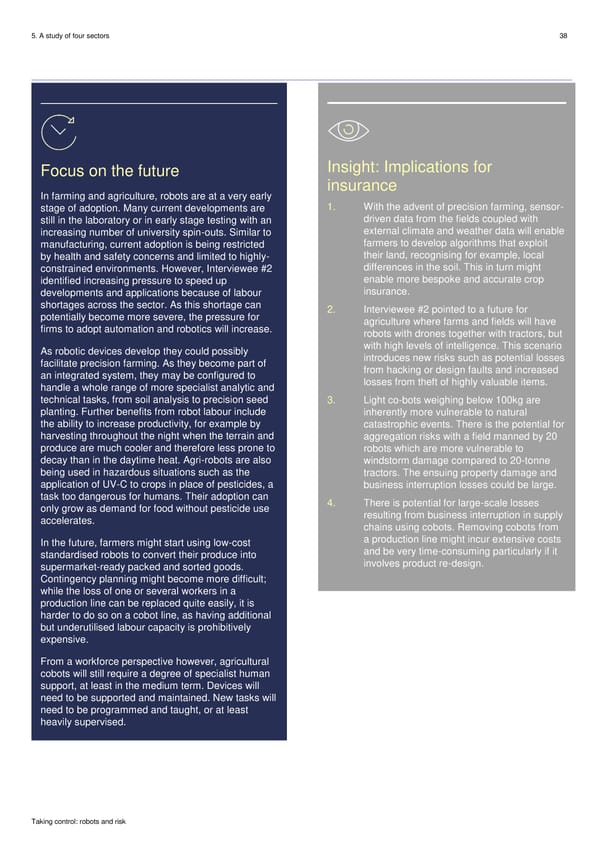5. A study of four sectors 38 Focus on the future Insight: Implications for In farming and agriculture, robots are at a very early insurance stage of adoption. Many current developments are 1. With the advent of precision farming, sensor- still in the laboratory or in early stage testing with an driven data from the fields coupled with increasing number of university spin-outs. Similar to external climate and weather data will enable manufacturing, current adoption is being restricted farmers to develop algorithms that exploit by health and safety concerns and limited to highly- their land, recognising for example, local constrained environments. However, Interviewee #2 differences in the soil. This in turn might identified increasing pressure to speed up enable more bespoke and accurate crop developments and applications because of labour insurance. shortages across the sector. As this shortage can 2. Interviewee #2 pointed to a future for potentially become more severe, the pressure for agriculture where farms and fields will have firms to adopt automation and robotics will increase. robots with drones together with tractors, but As robotic devices develop they could possibly with high levels of intelligence. This scenario facilitate precision farming. As they become part of introduces new risks such as potential losses an integrated system, they may be configured to from hacking or design faults and increased handle a whole range of more specialist analytic and losses from theft of highly valuable items. technical tasks, from soil analysis to precision seed 3. Light co-bots weighing below 100kg are planting. Further benefits from robot labour include inherently more vulnerable to natural the ability to increase productivity, for example by catastrophic events. There is the potential for harvesting throughout the night when the terrain and aggregation risks with a field manned by 20 produce are much cooler and therefore less prone to robots which are more vulnerable to decay than in the daytime heat. Agri-robots are also windstorm damage compared to 20-tonne being used in hazardous situations such as the tractors. The ensuing property damage and application of UV-C to crops in place of pesticides, a business interruption losses could be large. task too dangerous for humans. Their adoption can 4. There is potential for large-scale losses only grow as demand for food without pesticide use resulting from business interruption in supply accelerates. chains using cobots. Removing cobots from In the future, farmers might start using low-cost a production line might incur extensive costs standardised robots to convert their produce into and be very time-consuming particularly if it supermarket-ready packed and sorted goods. involves product re-design. Contingency planning might become more difficult; while the loss of one or several workers in a production line can be replaced quite easily, it is harder to do so on a cobot line, as having additional but underutilised labour capacity is prohibitively expensive. From a workforce perspective however, agricultural cobots will still require a degree of specialist human support, at least in the medium term. Devices will need to be supported and maintained. New tasks will need to be programmed and taught, or at least heavily supervised. Taking control: robots and risk
 Robots & Risk Page 37 Page 39
Robots & Risk Page 37 Page 39